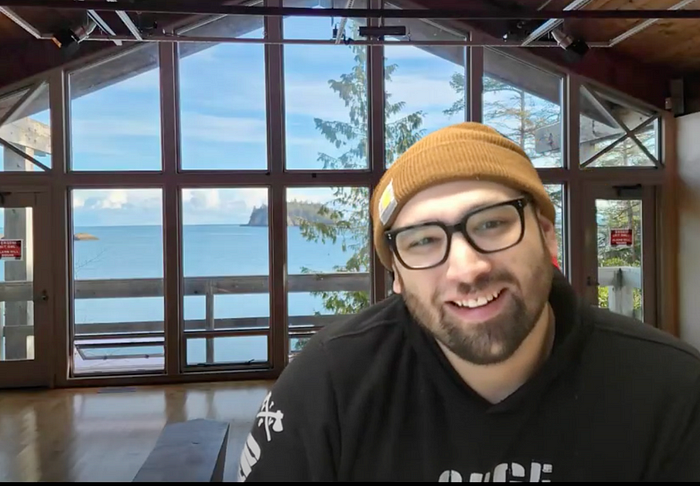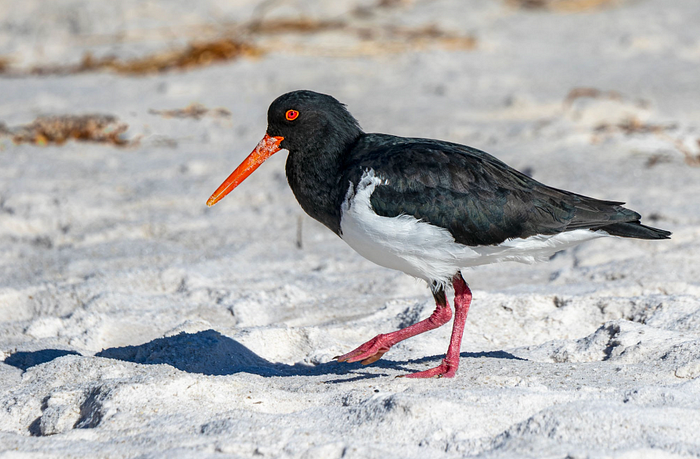Long-Term Observational Science Through Oral History at the Haida Gwaii Museum
On a beautiful day in Haida Gwaii, host Jayson Moore brought classrooms from all over together with curator SGaan Kwahagang (James McGuire). Moore joined virtually from UBC and classes joined from Chief Matthews School, Sk’aadgaaNaay, Selkirk Elementary School and other locations for a unique learning opportunity. Notably, this is the first occasion both Haida Gwaii elementary schools were able to gather virtually for a learning opportunity, making it an extra special occasion. Everyone was gathered to learn about how oral histories have been sharing for tens of thousands of years the same ideas expressed in Western science.

Standing in front of the backdrop of the beautiful ocean, fluffy clouds, and tall trees visible from the Saahlinda Naay (Saving Things House), SGaan Kwahagang starts by sharing about oral histories.

“Oral histories bring us to a place of understanding of the place that we live in. Oral histories for Indigenous people exist in territories all over the world. Whatever place that you’re in, the Indigenous people of that place have oral histories that span the length of thousands and thousands of years. What some of these stories tell us is the way that the forces around us interact and govern the way that we exist within these territories.”
SGaan Kwahagang shared Tale of Two Winds or The Oystercatcher, a traditional Haida story in English and students were invited to draw the story as they heard it with their creative hats and their listening ears on. There is no right or wrong way to interpret the story, they are told and their creativity is encouraged.

The story was of the marriage between the winds, and it described many weather phenomena as expressed through the family relationship and lives of the characters in the story. Students learned about limpets (little snails) and SGaan Kwahagang told the story with an animated expression, chuckling and making sound effects along the way. The young audience was captivated by his vocal talents.
After hearing the tale, students shared their drawings, their creative talents praised and affirmed as they pressed the images they created against the cameras and explained their drawings. Their confidence in sharing what they learned was clear and the safety of the learning experience emboldened them to express themselves in front of their peers across the country.
Through the storytelling experience, students had the opportunity to learn about weather systems in an engaging way. While Western science’s way of communicating atmospheric pressure systems can be dry, the personification of the systems at play made the story relatable and interesting. It made sense to a young audience and held their attention.
SGaan Kwahagang explained how Haida Gwaii’s weather is dictated by the relationships between high and low-pressure systems and the Oystercatcher story explains these relationships in an accessible way. To help apply the lessons from the story, SGaan Kwahagang shared stories of recent weather patterns and how they related to the story he shared. He also explained how students could apply the story to their own lives as observers of weather.

“After listening to the story, you can recognize the characters and understand what the weather is going to be like. You‘ll be able to see the characters in the story and you’ll be able to understand that these signs are telling you what the weather is going to be tomorrow and the next day and the day after that,” he elaborates.
SGaan Kwahagang encouraged students to:

One of the reasons this practice is so important and so transferable across the Connected North program is that in isolated areas, oral histories help residents understand the weather where there might be limited access to weather forecasting. “Oral histories tell us how to exist here and they were formed over tens of thousands of years,” SGaan Kwahagang explains.
Bringing together lessons from Western science and traditional stories, students are given two ways of understanding and remembering meteorological phenomena. This is described as “two-eyed seeing”, also known as Etuaptmumk in Mi’kmaq, and it’s a practice that is credited to Elder Albert Marshall. Connected North sessions like this very special experience increase learning opportunities and access to unique perspectives while providing chances for cultural exchange.
Háw’aa (thank you) SGaan Kwahagang and to all of our donors who contribute to valuable educational experiences like this one, sharing oral histories with a new generation of learners.
Thanks to Alison Tedford Seaweed for authoring this article.
